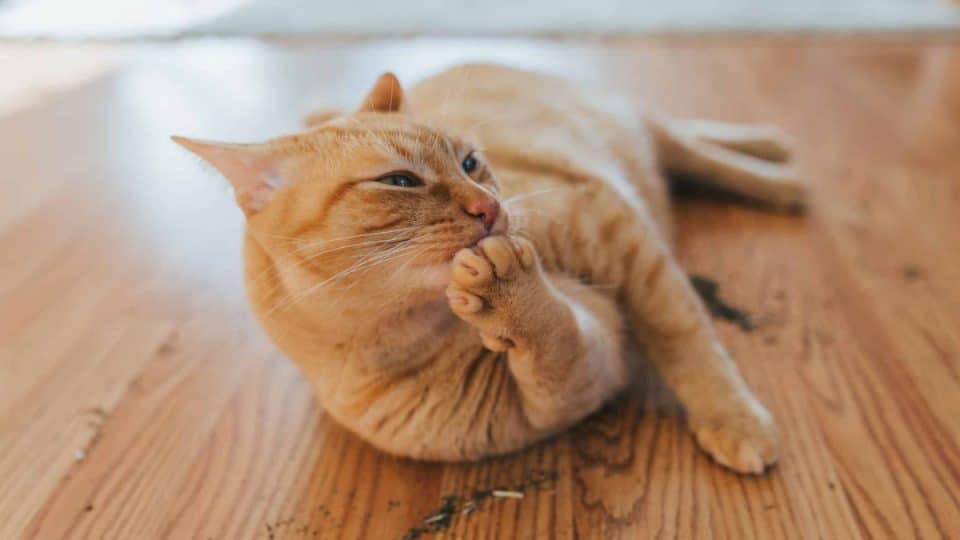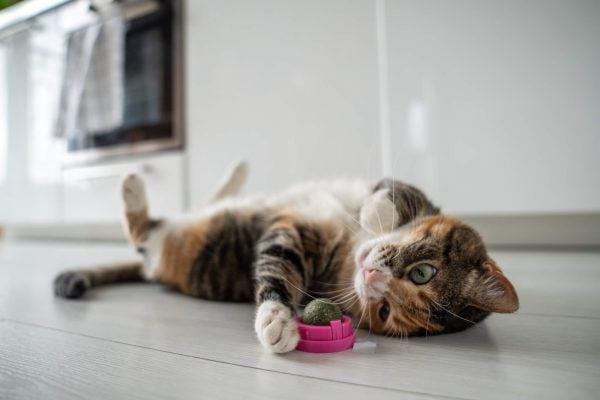- Not a substitute for professional veterinary help.
If your cat is sensitive to catnip, you’ve probably caught them doing some pretty curious things. This herb, also called catmint, catswort, and field balm, grows easily and is often found in the wild.
If your cat gets a whiff, they might roll around, lick the floor or themselves, vocalize, get extra playful, or even zone out! But what does catnip do to cats, exactly, that triggers this reaction?
Read on to learn the science behind your cat’s fascination with catnip and discover why this plant has such a profound impact on cats.
What Does Catnip Actually Do To Cats?
Catnip acts on a cat’s brain because it contains a chemical called nepetalactone. This chemical is secreted from the oil in the plant’s leaves and stems, and it acts similarly to feline pheromones. In fact, many cats find its smell irresistible.
When cats inhale catnip, nepetalactone molecules bind to receptors in the nose and send signals to various parts of the brain, including the amygdala and the hypothalamus. This activates a cat’s reward and pleasure systems and leads to the euphoric behavior you notice.
Some evidence also suggests that catnip activates opioid receptors in your cat’s brain. In one study, researchers gave cats naloxone, a drug used to treat opioid overdoses in people. The researchers discovered this opioid blocker reduced or eliminated the effects of catnip.
Common behaviors triggered by catnip
If your cat has encountered some catnip, you might notice:
Not every cat reacts in the same way, and some cats may not respond to catnip at all! Sometimes, catnip has a sedative effect, so your cat may seem extra docile and still.
The effects of catnip don’t last long. You can expect them to last anywhere from 5 to 15 minutes. After this period, cats recover their senses and develop a catnip immunity that lasts for about an hour.
Does Catnip Make Cats ‘High’?
A catnip “high” may resemble the buzz people get from cannabis or alcohol, experts haven’t found any evidence to suggest catnip works in the same way as recreational drugs.
One of the biggest differences between the experience humans have when using those substances and the experience cats have with catnip is that catnip doesn’t impair cats, explains Joey Lusvardi, a certified cat behavior consultant and the founder of Class Act Cats.
Catnip does, however, seem to make cats feel good. For one, Lusvardi says the behaviors caused by catnip are generally associated with cats being in a good mood. Moreover, catnip can help cats build positive associations with new or scary things.
Another clue that catnip is pleasurable for cats is their tendency to seek it out. “Cats don’t often seek out things they don’t find enjoyable!” Lusvardi points out.
Is Catnip Good For Cats?
Catnip is perfectly fine for cats. It’s a safe way to provide kitty enrichment and offers both behavioral and physical benefits to cats.
According to Lusvardi, catnip can:
- Create positive associations with new environments, cat carriers, cat beds, and more
- Encourage cats to use things like scratching posts or self-cleaning litter boxes
- Encourage active play, which keeps cats fit and mentally engaged
- Reduce anxiety and stress
- Act as a natural mosquito repellent for cats
Is it ok for cats to eat catnip?
Catnip is safe for cats to eat—but this will have a different effect.
The smell of catnip tends to give cats a stimulating burst of energy, while eating it tends to have more of a calming, sedative effect. Although cats generally won’t get sick from eating catnip, eating too much can cause nausea or diarrhea.
When is catnip bad for cats?
The effects of catnip are completely safe, and cats won’t develop an addiction to it, either. For the most part, it’s fine to give catnip to any cat, with just a few exceptions:
- Pregnant cats: Some experts believe catnip can cause premature labor. Catnip may also cross into the placenta and affect unborn kittens, so it’s best to avoid giving catnip to a pregnant cat.
- Cats who experience seizures: According to research, catnip can cause seizures in mice, so cats may experience a similar effect.
- Cats who show aggressive behavior: Sometimes, catnip can amplify aggressive behavior in cats. Lusvardi also says catnip may worsen tension between cats who don’t get along.
How Old Do Cats Have To Be To Have Catnip?
Catnip won’t hurt your kitten, but it won’t have much of an effect, either.
“Most cats will begin showing a response to catnip somewhere between the age of 6 months and 1 year,” says Lusvardi.
If your senior cat doesn’t seem as interested in catnip as they did in their younger years, that’s perfectly natural. Lusvardi says senior cats tend to have a diminished response to catnip.
Which Type Of Catnip Works Best?
Catnip comes in a few different forms, and some cats may prefer one over the other.
- Fresh herbs: Just like with any herb, fresh is best. It’s more potent than the dried variety—which means you can give your cat less of it. Catnip is easy to grow but invasive, so you might consider growing it in a pot or a planter with other favorites, such as cat grass.
- Ground and dried: Dried catnip is also extremely effective, though the essential oils tend to lose their power over time. Look for tubs of quality catnip at pet stores. Ideally, these will contain just the leaves and flowers with no stems.
- Catnip toys: Whether your cat likes to chase, chew, nuzzle, or scratch, there’s a catnip toy for every style of play. Refillable plushies keep the fun going, and catnip-infused wall toys offer a unique hybrid of toy and treat.
- Catnip sprays: A few spritzes of catnip oil-infused spray on toys, beds, or scratchers can make them more appealing. It’s also a tidier option than sprinkling dried catnip everywhere.
What If My Cat Doesn’t Like It?
If your cat doesn’t react to catnip, you can try other plants that are safe for enrichment, play, or relaxation.
- Silvervine: In one study, 75% of cats unaffected by catnip responded to silvervine. This plant activates the reward center in cats’ brains and triggers a euphoric response similar to catnip.
- Valerian root: This plant is a stimulant for cats and may cause them to roll around, purr, drool, and rub against things.
These catnip alternatives come in many forms, including chew sticks, finely ground powder, and wall toys.
Can Dogs Have Catnip?
If you have both cats and dogs, you don’t have to worry about keeping catnip away from your dog—it’s safe for dogs, too!
Not all dogs will respond to catnip, but for some dogs, the herb acts as a mild sedative and can help with anxiety, GI issues, and sleeping problems.
Takeaway
Catnip is one incredible herb. Not only is it just plain fun for some cats, it also works as a tool for training. Just sprinkle a little on new scratching posts and kitty beds to attract your cat to them!
You can also store special toys in a canister with dried catnip to infuse them with that amazing catnip smell. Enjoy all the batting, rolling, chasing, and kitty antics to follow!





